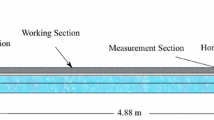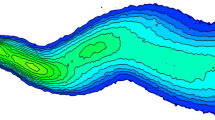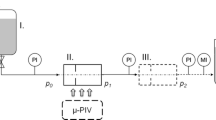Abstract
An experimental investigation of water flow in a T-shaped channel with rectangular cross section (20 × 20 mm inlet ID and 20 × 40 mm outlet ID) has been conducted for a Reynolds number Re range of 56–422, based on inlet diameter. Dynamical conditions and the T-channel geometry of the current study are applicable to the microscale. 2-D planar particle imaging velocimetry (PIV) and laser-induced fluorescence (LIF) were used in multiple locations of the T-channel to investigate local dynamical behaviors. Steady symmetric and asymmetric flow regimes predicted in the literature, which is largely numerical, are experimentally verified. Unsteady flow regimes, which are numerically predicted to occur at higher Re but have not yet been experimentally characterized, are also examined, and real-time LIF results illuminate the evolution of unsteady structure. Experimental data of the present resolution and scope are not presently available for unsteady flow regimes. Time scales are presented for unsteady flow regimes, which are found to exhibit periodic behavior and to occur for Re ≥ 195. An unsteady symmetrical regime is identified for Re ≥ 350 that is detrimental to mixing. Momentum fields and dynamical behaviors of all flow regimes are characterized in detail, such that published mixing trends may be better understood. Results of all experimental trials were used to construct a regime map. A symmetric topology is found to be dominant for Re from 56 to 116, when flow is steady, and 350 to 422, when flow is characterized by unsteady stagnation-point oscillation in the T-channel junction. Asymmetric flow, which is positively indicated for mixing, is dominant for Re between 142 and 298, and the fluid interface exhibits both steady (two standing vortices) and unsteady (shear-layer type roll-up) behaviors. This result is based on multiple experiments and suggests a practical operating range of 142 ≤ Re ≤ 298 where asymmetric flow is highly likely to experimentally occur. The identification of an upper limit on Re, beyond which mixing appears negatively impacted by a more symmetrical momentum field, is practically important as pressure drops on the microscale are significant.

















Similar content being viewed by others
References
Adrian RJ, Aref H, Beebe DJ (2000) Chaotic mixing in microfluidic systems. In: Solid-state sensor and actuator workshop, pp 187–190, Hilton Head Island, South Carolina, June 4–8 2000
Bertsch A, Heimgartner S, Cousseau P, Renaud P (2001) 3d micromixers—downscaling large scale industrial static mixers. In: Proceedings of IEEE MEMS, pp 507–510
Bothe D, Stemich C, Warnecke H-J (2006) Fluid mixing in a t-shaped micro-mixer. Chem Eng Sci 61:2950–2958
Branebjerg J, Gravesen P, Krog JP, Nielsen CR (1996) Fast mixing by lamination. In: Procedings of IEEE MEMS, pp 441–445
Choi J-W, Ahn CH (2000) An active micromixer using electrohydrodynamic (ehd) convection. In: Solid-state sensor and actuator workshop, pp 52–55, Hilton Head Island, South Carolina, June 4–8 2000
Deshmukh AA, Liepmann D, Pisano AP (2000) Continuous micromixer with pulsatile micropumps. In: Solid-state sensor and actuator workshop, pp 73–76, Hilton Head Island, South Carolina, June 4–8 2000
Deval J, Tabeling P, Ho C-H (2002) A dielectrophoretic chaotic mixer. In: Proceedings of IEEE MEMS, pp 36–39, Las Vegas, Nevada, January 20–24 2002
Drazin PG, Reid WH (1981) Hydrodynamic stability. Cambridge University Press, Cambridge
Dreher S, Kockmann N, Woias P (2009) Characterization of laminar transient flow regimes and mixing in t-shaped micromixers. Heat Transf Eng 30(1–2):91–100
Ehlers St, Elgeti K, Menzel T, Wiebmeier G (2000) Mixing in the offstream of a microchannel system. Chem Eng Process 39:291–298
Engler M, Kockmann N, Kiefer T, Woias P (2004) Numerical and experimental investigations of liquid mixing in static micromixers. Chem Eng J 101:315–322
Gobert C, Schwertfirm F, Manhart M (2006) Lagrangian scalar tracking for laminar micromixing at high schmidt numbers. In: Procedings of FEDSM2006
Hao P-F, Yao Z-H, He F, Zhu K-Q (2006) Experimental investigation of water flow in smooth and rough silicon microchannels. J Micromech Microeng 16: 1397–1402
Ho C-M, Tai Y-C (1998) Micro-electro-mechanical systems (mems) and fluid flows. Annu Rev Fluid Mech 30: 579–612
Hoffmann M, Schluter M, Rabiger N (2006) Experimental investigation of liquid-liquid mixing in t-chaped micro-mixers using micro-lif and micro-piv. Chem Eng Sci 61:2968–2976
Kandlikar S (2008) Exploring roughness effect on laminar internal flow-are we ready for change?. Nanoscale Microscale Thermophys Eng 12(1):61–82
Kandlikar S, Schmitt D, Carranoc A, Taylord J (2005) Characterization of surface roughness effects on pressure drop in single-phase flow in minichannels. Phys Fluids 17
Karniadakis G Em, Beskok A (2002) Micro flows, fundamentals and simulation. Springer, New York
Koch M, Chatelain D, Evans AGR, Brunnschweiler A (1998) Two simple micromixers based on silicon. J Micromech Microeng 8(2):123–126
Kockmann N, Engler M, Foll C, Woias P (2003a) Liquid mixing in static micro mixers with various cross sections. In: Proceedings of the first international conference on microchannels and minichannels 14:114–121
Kockmann N, Foll C, Woias P (2003b) Flow regimes and mass transfer characteristics in static micro mixers. In: Microfluidics, BioMEMS and medical microsystems: Proceedings of SPIE, volume 4982, pp 319–329
Kockmann N, Engler M, Woias P (2004) Convective mixing and chemical reactions in t-shaped micro reactors. In: Proceedings of the AIChE annual meeting, Austin, Texas, November 7–12
Lindken R, Hussong J, van Esch J, Westerwheel J (2008) Experimental and numerical investigation of the symmetry-breaking and flow bifurcation in a t-shaped micromixer. In: ECI International conference on heat transfer and fluid flow in microscale
Liu RH, Stremler MA, Sharp KV, Olsen MG, Santiago JG, Adrian RJ, Aref H, Beebe DJ (2000) Passive mixing in a three-dimensional microchannel. J Microelectromech Syst 9(2):190–196
Mitchell P (2001) Microfluidics: downsizing large-scale biology. Nat Biotechnol 19:717–721
Miyake R, Lammerink TSJ, Elwenspoek M, Fluitman JHJ (1993) Micro mixer with fast diffusion. In: Procedings of IEEE MEMS, pp 248–253
Nguyen N-T (2005) Micromixersúa review. J Micromech Microeng 15: 1–15
Rawool AS, Mitra SK, Kandlikar SG (2005) Numerical simulation of flow through microchannels with designed roughness. Microfluidics Nanofluidics 2(3):215–221
Silva G, Leal N, Semiao V (2008) Micro-piv and cfd characterization of flows in a microchannel: velocity profiles, surface roughness and poiseuille numbers. Int J Heat Fluid Flow 29:1211–1220
SH Strogatz (1994) Nonlinear dynamics and chaos. Westview Press
Suzuki H, Ho C-M (2002) A magnetic force driven chaotic micro-mixer. In: Proceedings of IEEE MEMS, pp 40–43, Las Vegas, Nevada, January 20–24
Taylor J, Carrano A, Kandlikar S (2006) Characterization of the effect of surface roughness and texture on fluid flowúpast, present, and future. Int J Thermal Sci 45:962–968
Telib H, Manhart M, Iollo A (2004) Characterization of laminar transient flow regimes and mixing in t-shaped micromixers. Phys Fluids 16(8):2717–2731
Wazzan AR, Okamura TT, Smith AMO (1967) Stability of laminar boundary layers at separation. Phys Fluids 10:2540–2545
Weilin Q, Mala GM, Dongqing L (2000) Pressure-driven water flows in trapezoidal silicon microchannels. Int J Heat Mass Transf 43: 353–364
Wong SH, Ward MCL, Wharton CW (2004) Micro t-mixer as a rapid mixing micromixer. Sensors Actuators B 100:359–379
Author information
Authors and Affiliations
Corresponding author
Rights and permissions
About this article
Cite this article
Thomas, S., Ameel, T.A. An experimental investigation of moderate reynolds number flow in a T-Channel. Exp Fluids 49, 1231–1245 (2010). https://doi.org/10.1007/s00348-010-0863-7
Received:
Revised:
Accepted:
Published:
Issue Date:
DOI: https://doi.org/10.1007/s00348-010-0863-7




